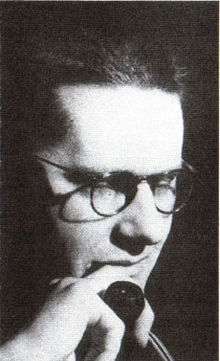Alfred Conlon
Colonel Alfred Austin Joseph (Alf) Conlon (7 October 1908 – 21 September 1961) was the head of the Australian Directorate of Research and Civil Affairs (DORCA) in World War II. A controversial figure, he influenced events throughout the Pacific region in the second half of the 20th century, through the Australian School of Pacific Administration (ASOPA), which grew out of the directorate.

Career
Conlon's parents were Arthur George Conlon, tram conductor, and Esther Mary, née Hayes. He was born at East Sydney and was educated at Fort Street Boys' High School and the University of Sydney, graduating BA in 1931.[1] He studied philosophy under the realist Professor John Anderson.[2] He began to study medicine in 1932 at the University of Sydney but interrupted the course to work as a law clerk and get married (in January 1936). The following year he returned to his medical studies and represented undergraduates on the university's senate in 1939–43. He also served as a (military recruitment) manpower and education officer in 1940–41.[1][2]
In April 1942, through a friend, the army's wartime adjutant-general Victor Stantke, Conlon became Major Conlon and head of the research section at the Australian Army’s headquarters, then at Victoria Barracks in St Kilda Road, Melbourne (which developed into the Army’s Directorate of Research and Civil Affairs). He had previously been chairman of the Prime Minister’s Committee on National Morale.[1][3][4]
Described as "a clever man and a brilliant talker",[3] "Svengali-like"[5] and notorious,[6] Conlon created the mysterious DORCA in part as a haven for artists and intellectuals to avoid repeating the slaughter of the best minds of a generation that had impoverished Australian culture in the First World War. Conlon was influenced by his first philosophy teacher, John Anderson, and by James Burnham's The Managerial Revolution, a book extolling the virtues of a bureaucratic meritocracy.[7]
Conlon was a charismatic figure, and had many friends in high places including H. V. Evatt and Herbert "Nugget" Coombs. He cultivated many contacts including Prime Minister John Curtin and General Thomas Blamey. In 1944, with Roy Wright, General Blamey and Howard Florey, Conlon developed the proposal for founding the John Curtin School of Medical Research.[3] Conlon became principal of ASOPA after John Kerr's resignation in 1948.
He resumed his medical degree at the University of Sydney in 1950 and graduated MB, BS in 1951, "with difficulty, and despite opposition from members of the faculty". He subsequently practised as a psychiatrist from his home in North Sydney until his death at the age of 53.[1]
References
- Conlon, Alfred Austin Joseph (Alf) (1908–1961) at Australian Dictionary of Biography, 1993. Online version accessed 27 May 2012
- Charlton, Peter Shadowy organisation had undue influence at "The Peace Generation", The Courier-Mail, Brisbane (undated). Accessed 27 May 2012
- Sligo, Graeme R. D. (‘Pansy’) Wright and WWII UMA Bulletin No 27, July 2010, pp.1–2, at University of Melbourne
- Pybus, Cassandra 2012. Conlon’s Remarkable Circus, in Gray, G.; Munro, D.; Winter, C. (2012). Scholars at War. ANU e-press. pp. 55–72. doi:10.26530/OAPEN_459517. ISBN 9781921862502.
- Heyward, Michael The Ern Malley Affair, Faber & Faber, London, 1993 p.88
- Parnell, Stephen Literature, libertines and Lenin's Wife Archived 2012-11-27 at Archive.today p.2 at Research Archive, University of South Australia
- Ryan, Peter "Third Thoughts on James Burnham", Quadrant Vol xlvii No 12, December 2003
Further reading
- The Backroom Boys: Conlon and Army's Directorate of Research and Civil Affairs, 1942–46, by Graeme Sligo, Big Sky Publishing, 2012
- Alfred Conlon: A memorial by some of his friends, Benevolent Society of New South Wales, 1963
- Brief Lives, by Peter Ryan, Duffy & Snellgrove, 2004 (chapter 3, pp. 28–61, is on Conlon)
- Conlon’s Remarkable Circus, by Cassandra Pybus, 2012, pp. 55–72, in Gray, G.; Munro, D.; Winter, C. (2012). Scholars at War. ANU e-press. doi:10.26530/OAPEN_459517. ISBN 9781921862502.
- Jim and the kiaps: 'a performing flea in A A Conlon's remarkable circus', by Harry Jackman, 1977, Quadrant v.21, No 3, pp. 71–74 (ISSN:0033-5002)
- Working in the shadows of war, by Peter Ryan, 2013, Quadrant, v.57, no.11, pp. 110–112 (ISSN: 0033-5002)
External links
- The ASOPA Archives (Australian School of Pacific Administration), by Keith Jackson